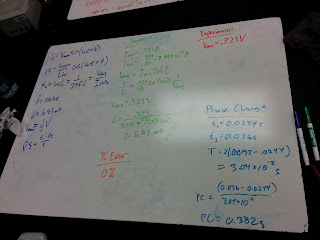We first created a relationship with impedance and current. We find that we can sub in our angular velocity times capacity for impedance. We were then asked what would happen if frequency was doubled. We were able to find that our current would double as a result.
The graphs above were generated by circuit with a frequency generator, resistor, and capacitor. The voltage and current were measured at a 10 Hz frequency.
The above two graphs were measured with a 1 kHz frequency and since the logger has a bit of internal lag, we had to measure current and electric potential separately.
In this picture we created a table of values for each of the frequencies that we tested. Most values were given by either our setup or the graphs. We first had to calculate our capacitive reactance so we could solve for our theoretical impedance. We then calculated the impedance Z from a Vmax and Imax from the graphs, and afterward we found that there was a huge discrepancy between our impedances. This was most likely due to the unknown resistance of the frequency generator. On the bottom we calculated our phase changes between the two graphs of voltage vs time and current vs. time.
The picture above illustrates resonance frequency. This is what occurs when the capacitive reactance and the inductive reactance are equal.
In the picture above we solve for power dissipated. The power dissipation relies solely on the resistor in this case.
We repeated the experiment, but this time with an inductor attached as well. The graph shown above was actually our output.

























































